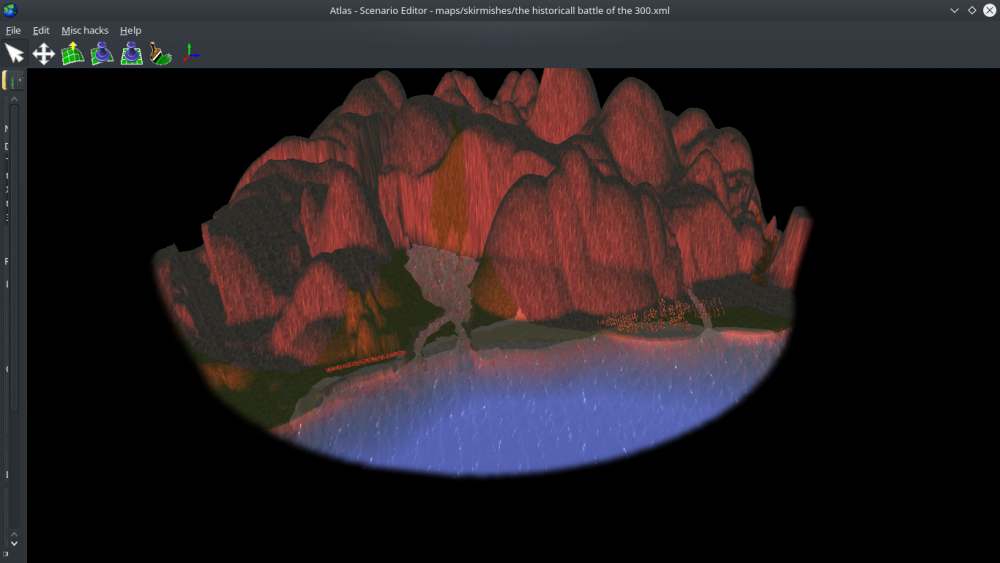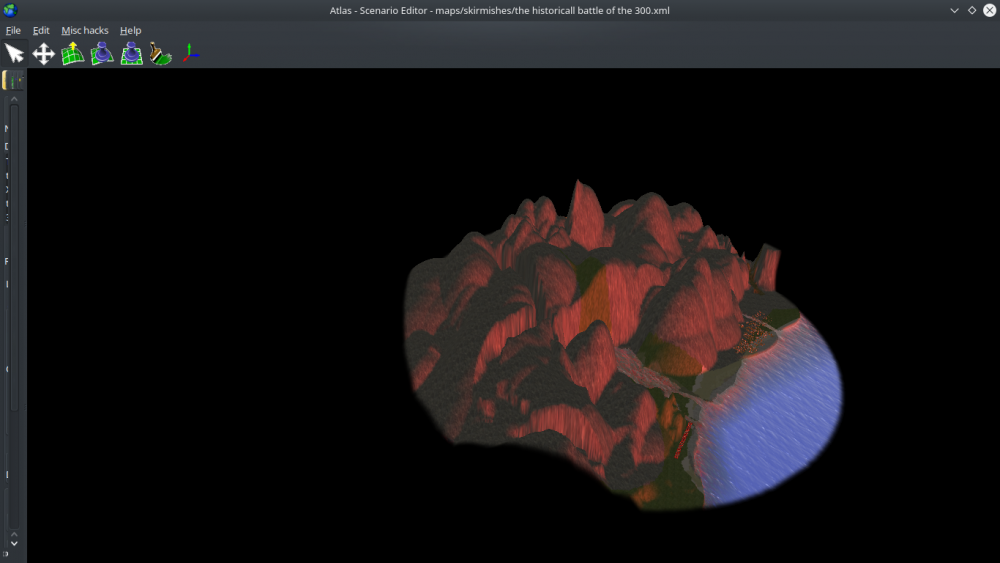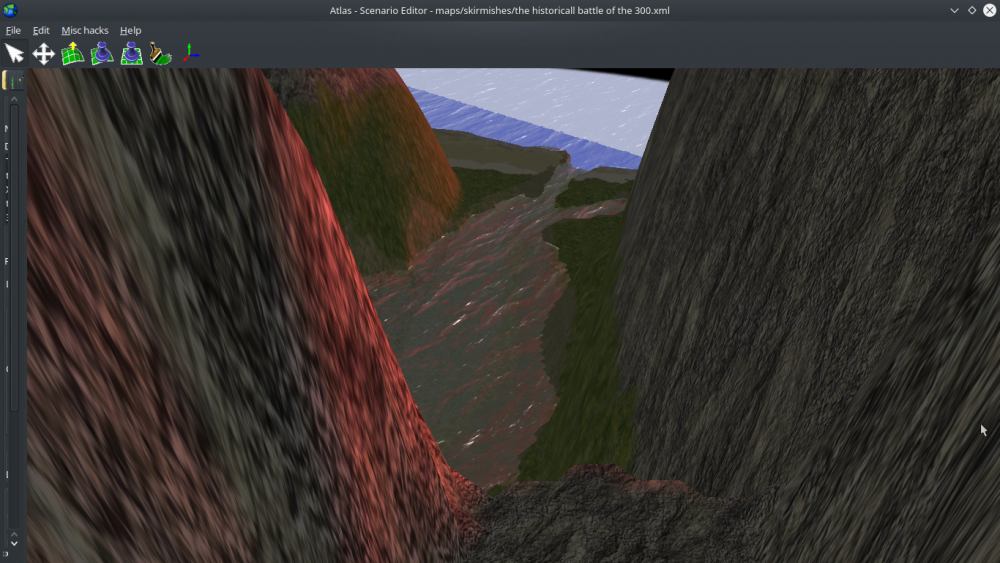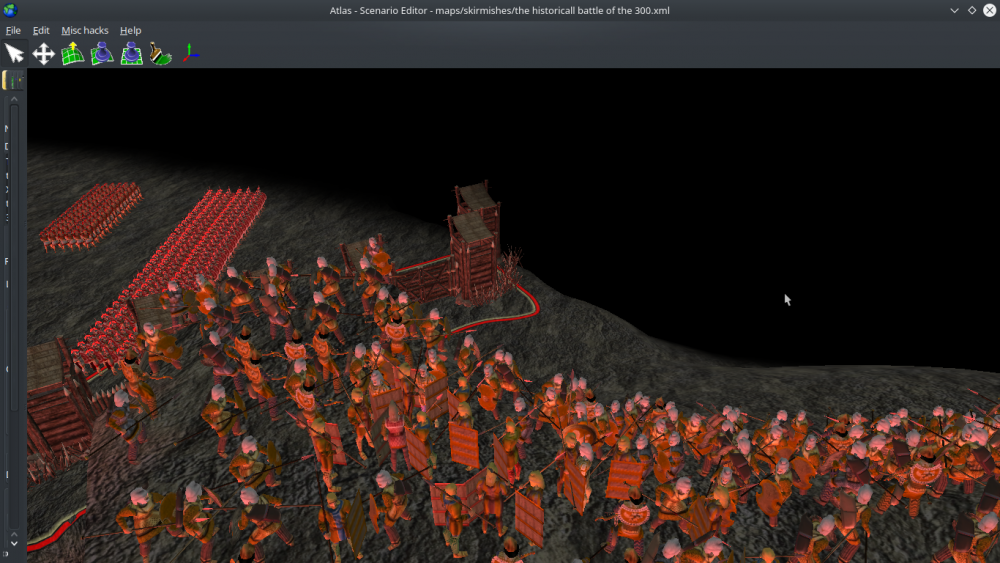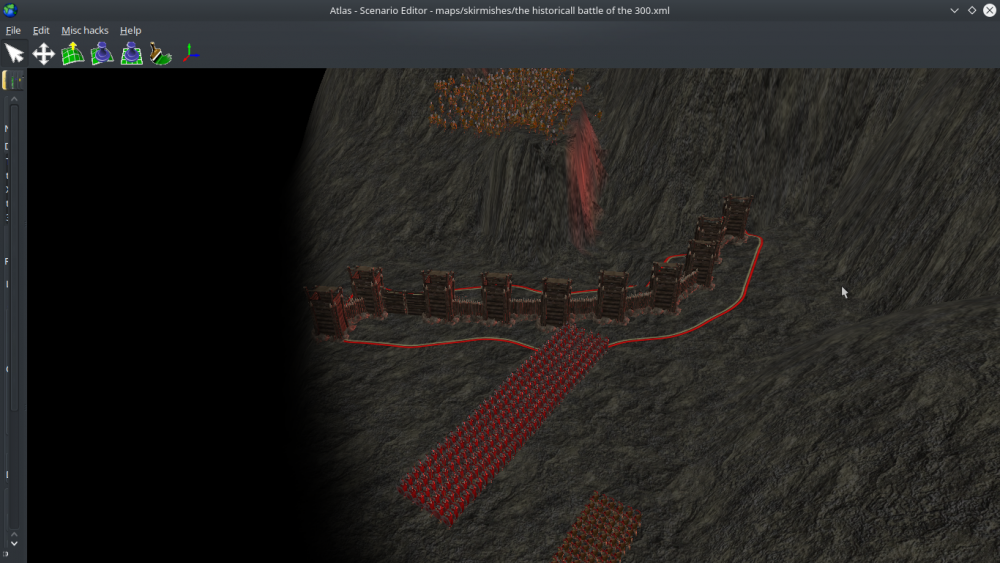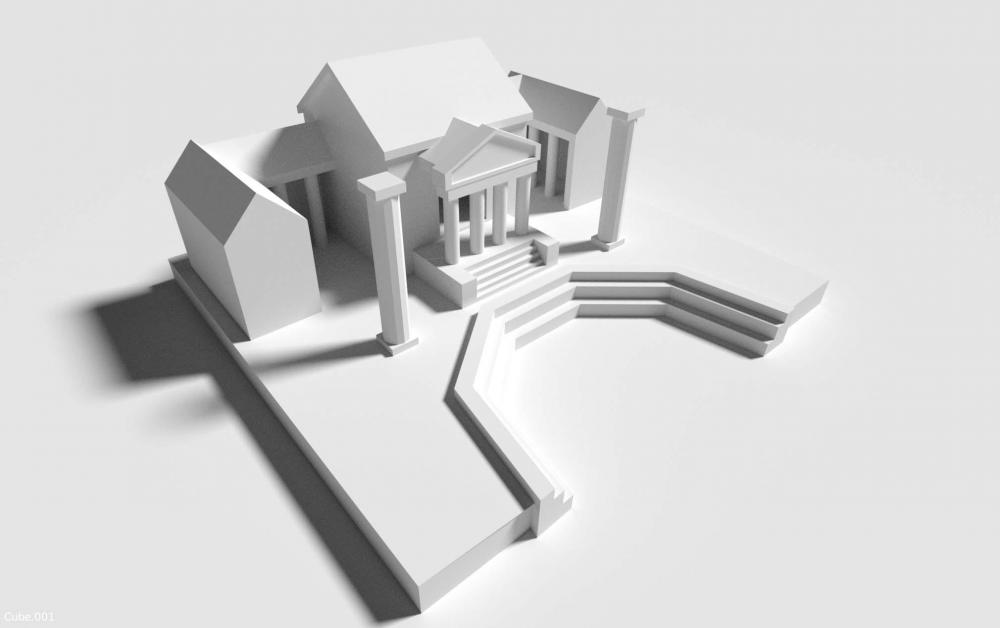Leaderboard
Popular Content
Showing content with the highest reputation on 2019-06-09 in all areas
-
Spanish lenguage by @Revan Shan Portuguese. French. Suggestion to other languages , here.3 points
-
3 points
-
I would say, however, that the flaw isn't necessarily with the presence of citizen-soldiers but their implementation. It should take time to mobilise troops, which could make the effects of a rush significantly more devastating as working time can be lost during the time the soldiers are preparing to defend themselves and then during the time they demobilise. It could be even harder if the rusher continuously cycles between different gathering areas, forcing the defender to take an active role in defence if they wish to survive. I've mentioned this idea before, but in fairness, few people seem to appreciate this concept. Definitely though, Darkreaver's concept is much better than the current iteration of the citizen-soldier.3 points
-
Well i made this car whit the weels animated but the animation looks like this in 0 ad I added actor and the blend file wtfAnimation.7z pickup_doble_cabina.blend2 points
-
2 points
-
Here is the video link: Here is the replay: @psypherium @Feldfeld @ValihrAnt @camel @Boudica @ffffffff @JC (naval supremacist) @Unknown_Player @borg- @chrstgtr @Lefo @Pudim @Philip the Swaggerless @Stockfish @PhyZik @itrelles @nani @Hannibal_Barca @LeGenDz @phoenixdesk @LANDLORD @kizitom *** If you want to be in the notification list, or not, send a PM so I can add/remove your name. 2019-06-09_0007.zip2 points
-
2 points
-
2 points
-
There's a difference between creating a mod that will be your own game (what LordGood talked about) or creating a mod to test out changes aimed at vanilla more easily. I was talking about the latter. The same way, you can use a knife to kill someone, so knives are bad if you're a peaceful person. So, by your logic, if you're a peaceful person, you should never, ever use a knife under any circumstances and good luck with trying to cut a slice of bread.2 points
-
2 points
-
2 points
-
This still doesn't remove the aspect that soldiers not gathering resources leads to the enemy gaining a resource lead while the attacker starts an attack. Considering that all units shouldn't move as fast as they currently do this is an issue nontheless, even with your (more fleshed out and more original concept). Another issue I have with this is that it adds additional, unnecessary micro for players. In 0 AD it's a nightmare to re-order male soldiers back to work after defending an attack. This is another reason why combat units usually do not gather resources. Also, this can lead to one player rushing the other, then attack and use his own soldiers to gather resources in the enemy base. This happens in AoE and is highly unrealistic - and it shouldn't work that way in a game that is intended to represent "authentic historic warfare". It's a much better thing to put automatic workers into buildings, call them villagers, slaves, hunters or whatever and let them gather resources automatically in range of their economy building. I.e. you build a Farmhouse, when finished 4 farm outlines appear next to it and a couple farmers automatically start generating food. Same with metal mines, wood camps and mines. Enemy units can raid and capture those structures and claim them for themselves. combat units do combat, and economy is done by economy building. The player who fights better and captures/destroys outposts wins.2 points
-
Hi folks, I have finished this new South East Asia map for 6 players. https://gitlab.com/CrazyBaboon/0ad_maps What should I do to upload the map onto the 0ad servers? Thanks!1 point
-
1 point
-
Resource & economy System revised This concept only covers economic features of civs. Military will be covered in a separate topic to keep this thing small. Some aspects of economy of course affect military as you’ll see later, but this is not the main argument at the moment. Military design and economic design will be tweaked to fit each other for every civ type. At first: I’d suggest to pair civilizations into groups (i.e. Hellenic Civs, Nordic civs, Indian/African civs and so on). I’ve covered Gauls, Britons, Iberians, Spartans, Athenians and Seleucids so far as more-or-less specific layouts. This again is not a 100% finished layout with every detail covered. Instead it's a general guideline to differ civs from each other and allow to create unique game play patterns for each of them. More than they currently are. The other civs will come later as I need to create something unique for them aswell. I’ll expand this concept for them in the next update(s). A .pdf is attached to be bottom of this post. (edit: I rewrote some parts because they contained some spelling errors. Should be more readable now) I. General thoughts on resources Every strategy game requires resources. The resources have to fit the game and players should have a choice whether collecting which resource is more important to them (strategic diversity). Each resource needs to fulfil a certain “role” that gathering it accomplishes it. To prevent “overburdening” the game with resources there has to be a flow in the game to naturally lead players towards gathering new resources (i.e. a progression from resource A into resource A+B into resource B etc.). Resources that already are gathered by players may not become redundant (because it’s replaced by another resource). If this is done well the economy management doesn’t become boring or unhealthy for the game and allows interesting, different types of playstyles where players decide how they are going to prioritize their gathering and army setups. Citizen/cavalry gatherers removed Yes I know this is a drastic change from the current concept. Yes, it will require reworking parts of the game. However, this is also the opportunity to improve the overall gameplay quality. Advantages of Citizen Soldiers/gatherers: - Usage of military units when not in combat - Especially cavalry can gather far away by hunting - Easy transition from economy to fighting Disadvantages of Citizen soldiers/gatherers: - No distinction between economic and military units (an integral part of every RTS) - Since many gatherers can be active at the same time (economic + every military) gathering rates have to be poor to avoid “economy explosions” which means that the resource income increases exponentially with each additional soldier - Players loose resources when attacking, short math example: o Soldier collects 0.5 food per second, 30 soldiers work as gatherers which means 15 food/second income (or 900 food/minute). Now if the 30 soldiers move to the enemy the player will lose 900 food every minute from his soldiers not gathering. Provided that the enemy has a similar army/economy that means that he’ll be ahead with 900 food for each minute he can gather (which would be equal to ~10 or more soldiers). o The attacking player needs to destroy more than 900 units worth of food every minute to get an advantage from his attack. If he can’t do that his attack actually weakens the Attacker instead of the Attacked -> unbalanced by design o Fixes: soldiers move at unrealistic ultra high speed (less time to get to the enemy) or lowering the gathering rates. The issue is the same still, attacking player initially has a large disadvantage - There is no progress from weakest -> strongest unit. Instead the players already start at a high level and then only progress in very small steps towards higher tech levels - Citizen soldiers discourage capturing as they are efficient at protecting the base early on, rendering capture rather useless - To get citizens back to work is a very fiddly task and annoying compared to regular economic units Overall it’s better to adjust gathering to specialized units for each civ type instead of giving every civ the ability for soldier gathering. This makes civs more diverse (-> more gameplay depth). One (poor) game mechanic lost for a massive gain in playability is more than worth it. Building layout (general) 1. Civic Centers are buildable from the start. City influence radius reduced. Can train a weak “militia type” unit and slingers. Slingers can be used to help hunting and Militias are weak units that can be used to harass and defend. Both units hard counter each other (slinger > militia, but in close combat militia beats slinger because of much lower hitpoints) 2. Storehouses, Sitobolon structures buildable in neutral territory 3. Farms require neutral territory, affected by gathering duration (fertility) – fields initially generate resources very slowly, but the rate increases the longer it is harvested by gatherers. When the gathering stops the field fertility decreases. To-do: Generate map areas in which farms are more productive (a possible map control element) 4. Military structures are postponed to City Phase, units are split up and not available all at once – either by per-building upgrades (only coding required, could be a workaround) or by splitting up the buildings into classes – Barracks, Stable, Archery range type classes (requires artworks), depending on civ type. Gatherer Limits: Food: 2/4 (for small/large food sources) Wood: 3 (for all trees) Stone, Iron, Silver: 3/5 (like food) Food – basic resource. Used for training units, upgrades (military), melee infantry & slingers, City advancing Wood basic resource. Used for military training (support/ranged units, ships). Used for economic upgrades, use for low tier buildings Stone – resource that constructs high tier buildings and expansions (civic centers, barracks, temples, gymnasion etc.) Iron - basic military resource, all basic melee military units require metal (swordsmen, pikes and cavalry). Silver - advanced military resource - is important for military improvement techs and used for training superiors, elite units. Slow to gather. Population - instead of being only connected to houses, population is influenced by city size (village - town - metropolis). Required to train units (obviously) Population cap (thoughts) Houses are hardcapped at ~10 houses per city. Depending on city level they can provide 10-20-30 population each. Alternatively: Military requires no population and is only depending on the food that is available from gatherers. Gatherers require population from houses and are hard capped per city. In a logical sense, soldiers that are at war do not sleep in houses, so it's rather strange that they take up pop from the city houses. Instead, armies rely on being supplied with food, water, weapons etc. from their home cities. This concept could be further elaborated, as I think it would fit the city Advance system. Alternatively, each city grants a fixed amount of population. Houses then are scrapped. I'd keep houses for the sake of being authentic though. houses belong into cities. Upgrade System Phase advancing: Food and Stone Economic upgrades: Lumber and Iron Military unit unlocks: Food/Lumber & Iron (ranged and melee units) Military unit type upgrades: Food and Silver Blacksmith “System“ Blacksmiths automatically reduce army Iron costs and increase the training speed for Sword wielding units. It can further research Metallurgy type techs that allow faster training, and allow further, cheaper unit production. Upgrades are not tied to City Phases anymore. Concept: Blacksmith generates “experience ranks” over time which allows more advanced upgrades to be researched. Corrals Can garrison captured herdables to provide food over time. Idea taken from the "intended" version of 0AD which isn't finalized yet. Gameplay reasoning There should be a transition from one type of resource to others, similar to this: food -> wood -> metal -> stone/silver. Players are not overly confused with gathering many resources from the start. As the game progresses the economy complexity increases. Early civic center expansion allows to take additional gathering spots and economic advances. Gatherers training times can be increased since it's possible to train them in multiple buildings. Since gathering spots are limited there has to be economic expansion to fit all gatherers to the spots. Phase advances that require stone - this way, players automatically need to gather a resource that will be more important in city phase, i.e. to build Phase II buildings. Military unit upgrades (like “advanced training” or unlocking certain units) create a resource transition towards Silver. II. Hellenic Factions (Sparta, Athen, Seleucids) Economic concept: Hellenes are defensive civs, and thus have bonuses for foraging berries and decent farming. Gathering rates are comparably high, so they can exhaust their own resources more quickly. Slaves are free gatherers that can be trained, have a hardcap that can be increased with City Phases and Slavery Techs. Athen speciality: silver mines last 20% longer Sparta speciality: slaves have 10% faster gathering rates, hoplites 15% faster, start at veteran rank Seleucid speciality: farming rate +50% (rate at which farming productivity increases) Gatherer types: Women (50 food, 1 pop) Gather rates: food Hunt : 1.25 herdables : 1.25 berries : 1.50 grain : 0.80 Gather rates: wood Trees: 0.6 rubble trees: 1.2 Gather rates: stone Quarries: 0.4 rubble stones: 0.8 Gather rates: iron Iron mines: 0.3 ambient iron: 0.6 Gather Rates: silver Silver mine: 0.2 Slaves (no cost, no pop. Have a hardcap) Gather rates: food Hunt : 1.4 herdables : 1.25 berries : 1.00 grain : 1.00 Gather rates: wood Trees: 0.8 rubble trees: 1.2 Gather rates: stone Quarries: 0.8 rubble stones: 1.2 Gather rates: iron Iron mines: 0.6 ambient iron: 1.2 Gather Rates: silver Silver mine: 0.4 A second type of gatherer that excels at mining. There are 2 options for them to be limited: either they automatically start to loose health if there are too many at one place, or they are simply hardcapped by default. It would be interesting to utilize capturing features to increase the maximum slave count. I.e. for 5 wounded/killed soldiers on the battlefield the number of slaves trainable increases by 1. So, by slaying enemy units the economic power rises for Hellenic civs. Due to the amount of gatherers per resource spot, having hundreds of slaves isn’t profitable as there is a need for more gathering spots to collect resources from. Buildings: Economic: wood only Military: wood and stone Civic: stone and food Iron: none Silver: none III. “Alpine” Civilizations (Iberians, Gauls, Britons) Economic concept: Opposed to Hellenes civs “nordic” civs rely more on hunting. They are mainly offensive civs to start with. Their buildings do not require much stone (if at all) but are less sturdy. Gathering rates are lower for farming and mining stone. The treadmill can be used to increase farming at a later civ stage to bring them on par with other civ’s lategame food economy. Early huntables creates power spikes because they can advance quickly and field armies in a shorter period of time. Also, this allows more spreading and early expansion. While Hellenes need to consider how many cities they can supply and defend, the Nordic civs can play a rather mobile earlygame with rushes and lots of interaction with gaia. Civ special advantages: villagers and Hunters receive weapon upgrades from the Blacksmith. Iberian speciality: Start with additional metal, soldiers have 20% bonus speed, iron gathering +15% Gauls speciality: +50% bonus damage against animals, units that are hunting have higher accuracy Cavalry +20% faster Britons speciality: Gathering from herdables +50%, herdables in stables provide more food Villager (50 food, 1 pop) Gather rates: food Hunt : 1.5 herdables : 1.5 berries : 1.0 grain : 0.60 Gather rates: wood Trees: 0.7 rubble trees: 1.2 Gather rates: stone Quarries: 0.2 rubble stones: 0.6 Gather rates: iron Iron mines: 0.4 ambient iron: 0.8 Gather Rates: silver Silver mine: 0.2 Villagers are both male and female. They can utilize spears or bows for hunting. Melee defense with knifes/swords. Hunter (80 food, 40 wood, 1 pop) Gather rates: food Hunt : 2.5 herdables : 2.25 berries : 1.50 grain : 0.80 Gather rates: wood Trees: 0.6 rubble trees: 1.2 Gather rates: stone Quarries: 0.4 rubble stones: 0.8 Gather rates: iron Iron mines: 0.3 ambient iron: 0.6 Gather Rates: silver Silver mine: 0.2 Hunters are mounted gatherers that can move swiftly around. They attack with spears and with upgrades/veterancy level they perform as a skilled mounted skirmisher unit. They can harass from the start, but due to a low attack rate with miss chance they are not that good to hit moving gatherers. As they kill animals their rank increases and they become more effective at raiding enemy economic units. Buildings: Economic: wood only Military: wood only Civic: wood and food (!) Iron: none Silver: none edit: removed-Special building : Corrals IV. Map control elements The game should be dynamic. Players should have options for economic expansion and there should be fluent progress on the whole map, with increasing intensity towards mid and lategame. Many current RTS games revolve around a central “base” from which all major actions are taken. Units trained, teching accomplished, resources gathered etc. Outposts or second bases have less priority because the risk – reward ratio (hard to defend, little benefits in return) is high. For 0 AD I’d like to propose a concept of “fluent expansion”. Since this game features unique aspects – city borders, city phases and a default capturing system for every military unit it would be beneficial to actually concentrate on these aspects. To further emphasize the city progression and the construction of an empire, it’s important to have interaction with the map. Constructing outposts – new cities – that can supply the Capital city to grow in prosperity and power should be a vital part for the course of the game. However, to avoid common issues from other RTS – economic expansion is punished hard by early rushes. Since eco management is pretty basic in many games, not punishing early economic expansion would lead to massive unitspam and create war of attrition, so it’s not desirable. Sort of basic and not very unique. Every game does that. 0 AD features a detailed economy, and so the early focus should actually be economic expansion. Only very basic military available that allows players to focus on where to expand, which positions are worth to create new cities etc. And then, as the game progresses, players can start gathering armies and start fighting. Many players enjoy “no rush” gametypes in which they can actually “build up” before the fighting starts – so rushing, even though it’s common in many RTS, is not the prime and sole option to solve games. By delaying military there is the option for players to satisfy their desire to “build” and then allows a fluent progression into fighting the enemy. How to achieve? 1. Allow military to interact with the map instead with the enemy only. By providing neutral targets that can be captured (like neutral Villages, cities, mercenary posts, slave posts, markets etc.) that can provide military and economic bonuses on a long term by increasing the player’s influence. 2. Allow military to attack positions apart from the main city. By providing multiple possible targets the strategical aspect becomes important – where to attack with how many units, fake attacks to disrupt the player, parallel harassment with multiple small armies which rewards multitasking, etc. 3. Distribution of map resources and hardcapping gatherers to force expansions. If players are forced to explore the map and expand to gain more resources it’s important to know and anticipate where and when the enemy is likely to expand. Game experience and strategical “what if” thinking and decision making is fun and rewarding. Ideas: Easiest: captureable herdables that can be used for food. Slave posts: automatically unlock the option to build slaves in cities for a silver cost. Mercenary post: train map type specific military units that provide additional tactical options in army compositions, instant and at a higher cost. Neutral cities: a small settlement or city with gatherable resources nearby, like a small gaul village, protected by some soldiers and has a couple of houses, maybe some farms. Can either be captured (expansion) or burned down to get immediate resource boost (food, iron, wood) Temples: neutral buildings that generate silver, or allow to train special types of support units that otherwise would only be available to certain civs (similar to a merc camp for non-combat units) Mines: generate iron indefinitely and work similar to farms How the actual implementation and which bonuses are provided is a secondary task. As long as the neutral building creates the urge for players to explore and expand it’s all fine. I’m open for additional ideas for neutral buildings for sure. 0ad Resource1.1.pdf1 point
-
Seems that the 4 civs have been leaked by Steam. Cumans, Lithuanians, Tatars and Bulgarians. I have some hope. While DE launch was a mess (altough I liked the graphics) seems that they retooke the game and Microsoft finally threw some budget to fix it (the last 3 patches) Probably AoE DE2 will start with AoE HD as a base. With some budget, they could improve the game. This is the star game of the saga, with more players1 point
-
1 point
-
Screenshots that sum up the trailer: Seems that there's not that much difference between AoE2 to DE2 in comparison to AoE1 and DE, specially on buildings. Announced features: 4K resolution, audio remastered, new campagin "The last khans". Some things that I noticed: the Indian architecture set it's used, probably for a new civ that uses a chataprhact lancer style. I guess that India officially won't use anymore the eastern set. Eastern European set have been improved. Seems that there's a new architecture set. And a civ with a chariot.1 point
-
1 point
-
you must remember is there are few minutes (11) from now. https://mixer.com/Xbox1 point
-
I'm sure that was a teaser... but nobody is sure. here is official Xbox (Ms) site with the hour. https://www.xbox.com/en-us/e31 point
-
the puzzle is done. the official streaming. https://mixer.com/Xbox1 point
-
Personally I think that the comitium and the curia are better representing a kind of civic center. This is the place for the assembly and for the senate. However I do understand that the comitium is not getting a lot of praise and could be ugly. The actual civic center is based on the Basilica Julia finished by Augustus. So using another basilica could be more coherent with the style. The only thing is that the basilica never existed during the first and second Punic Wars. This is a feature the Romans took from the Greeks after the second Macedonian War, based on their Stoa. The first basilica in Rome date from 184 BC (Basilica Porcia). This is a small inconsistency but nothing really problematic since we are still in the good period. A compromise could be the Basilica Opimia with in the front the Senaculum, the Ara Saturni and the Mundus. Like this there are some features of the old Roman tradition.1 point
-
Hi all, I would like to invite you to Sunday Pro Games - Final Week#8 live-stream event. There will be a 4v4 match at 18.00 (UTC) on Sunday with dual commentary by Alistair and Celtic Warband on his youtube channel. If you want to convert UTC time zone to your time zone you can visit this website. -You can Play/Watch/Contribute/Ask questions during the event. It's only one match once a week and this is the final week. So, Players who want to play should be in the room a little early. -You can check the current fixture from this post: League Fixture. -Players who want to Spec/Contribute/Ask questions should watch the event on Celtic Warband's channel: Here is the link. -We're playing the final week on Mainland / Autumn. -You can watch previous events on this channel. Please let me know If you have any questions. Have fun, @psypherium @Feldfeld @ValihrAnt @camel @Boudica @ffffffff @JC (naval supremacist) @Unknown_Player @borg- @chrstgtr @Lefo @Pudim @Philip the Swaggerless @Stockfish @PhyZik @itrelles @nani @Hannibal_Barca @LeGenDz @phoenixdesk @LANDLORD @kizitom *** If you want to be in the notification list, or not, send a PM so I can add/remove your name.1 point
-
1 point
-
1 point
-
That's because you forgot a vertex group for the Vehicle bone. If you assign the rest of the car to it it will work1 point
-
You should really use the quote feature of the forum. It makes it hard to distinguish your words from theirs1 point
-
The map isn't finished yet but here are some more screenshots. The next ones are the allies that held the second secret path. I didn't use height maps because it strangely didn't work, so I had to look at normal maps and do it just like that. So it's not quite realistic as it should be but it's more realistic as the first map I've posted . Hope you like it .1 point
-
It is mentionned in Learn to play > Manual, also if you select one or multiple units that have worked but have stopped, then the back to work button appears just near the repair one.1 point
-
Really??? omg... I never knew... So many awesome little details... Where is this mentioned? Shouldn't there be a clearly visible button?1 point
-
1 point
-
Spartan theatron needs to be redone, dont worry too much about that1 point
-
This topic can be very important, I'm looking at this moment by "special" units in all factions.1 point
-
The question is what someone wants to accomplish with this. AoE is like "we have female/male villagers" and 0 ad was like "ok let's split women and men villagers so it's different". There is no further reason for it. That's why I'm against the concept. I think the game would be better off scrapping the whole Citizen/women system, automate Economy by at least 75% and focus on building up cities and THEN creating armies and fight about map control elements like neutral cities and resources like quarries, Farmhouses and Mines. The whole detailed economy doesn't make much sense unless you focus the whole gameplay on it in a similar fashion of AoE and make the game a proper AoE clone. Which in itself is rather pointless because there is AoE DE, AoE 2 HD and AoE 2 DE coming out soon.1 point
-
1 point
-
1 point
-
Ctrl + middle mouse button to rotate the view Middle mouse button on its own pans the view, but I guess you've found that on your own1 point
-
I know you all guy have been waiting with holden breaths. I will synthesize some of Darcreavers ideas, along with comments and suggestions from others, and merge them with some concepts from my mod to propose a new gameplay for 0 a.d. I hope you guy like this. I commend you for reading all the way through. General Concept In general, most think there are structural problems with the game's design. I will not comprehensively rehash them here as there are a dozen threads on this topic. I will simply propose the vision and you guys and accept or reject it. So, in keeping with my mod, Delenda Est, I propose a "weak countryside, strong core" concept, but incoporporating some of what has been said over the past couple weeks. What I propose to do is also keep elements of the citizen-soldier concept, while also creating a hard battalions paradigm that also works with single units. The concept also takes into account many of Darc's criticisms and suggestions from others. Map Control Control of the map is crucial because of a few factors. Most important buildings, like houses and barracks, can only be built in the player's territory, so grabbing more land by building new settlements is important to population growth. These buildings are capped per settlement, so building more settlements and grabbing more land is important for building new buildings. Most resources are usually far away from the starting position of the player and are concentrated in impressive, lucrative depots. The countryside contains beneficial items like herd animals, which act like food relics, and mercenary camps, from which you can train 0-pop, fast-training mercenary soldiers. Grabbing territory or controlling the map deprives your enemy of the benefits of these things as well. Countryside Concept: Weak Countryside, Strong Core Players can now build Storehouses and Farmsteads in neutral territory. Most necessary resources are also placed in the neutral "no man's land" between starting territories of players, so now it's crucial to gather resources away from easy defenses. This is the "weak countryside." Territories now represent city-boundaries instead of national borders. Important buildings like barracks and fortresses and houses and markets must be built in the strong defensible core territory, while resourcing operations, like mining and farming, are done out in the dangerous countryside. This represents the reality of ancient times: the concept of national borders was not well-defined and many times nations and empires were separated by wild frontiers rather than by solid lines on a map. Settlement Phases, Territories, and Provinces Each Civic Center building casts a territory (Civic Centers, Wonders, and Fortresses are the only buildings to cast a significant territory range). This is a province, and each subsequently built civic center dynamically creates its own province, whose territory does not merge with an adjacent Civic Center's territory. So, each Civic Center's province is its own territory, size dictated by the Settlement Phase the province has attained, via the number of buildings built within it. Village Phase Small territory. Economic-focused. Hunt, gather berries, scout the map for herdable animals, treasures, mercenary camps, and neutral settlements. Set the foundation for your home settlement's progress. Food is the most important resource, while Wood becomes increasingly important as the player builds more buildings. Player is probably scouting heavily for farmlands, quarries, and mine shafts. Train Citizens from the Civic Center and Slaves from Storehouse and Farmstead. Citizens can upgrade to soldiers for a short time with the Town Bell for defense. More detail below in the 'Units' section. Palisade walls and wooden defense towers are available for defense. Town Phase Requires 10 buildings built within its province Territory grows by 25%. Unlocks barracks, blacksmith, market, shipyard, cult statue. Train your first citizen-soldiers and light warship. Stone and Iron now become a needed resource, for military buildings and blacksmith teching respectively. Player is probably heavily into farming on farmlands now and has captured a number of herdable animals that can be garrisoned in a corral for a free trickle of food. Stone walls become available and wooden defense towers can be upgraded individually to stone. Player may attempt to capture 1 or more neutral settlements on the map to gain a territorial advantage over the enemy. City Phase Requires 25 buildings built within its province Territory grows another 25%. Unlocks Fortress for heroes, champions, and siege weapons. Trade routes should be set up by now. New civic centers unlocked: Found new settlements now instead of only capturing neutral settlements. Mercenaries become part of the mix as mercenary camps are captured and the coin resource is acquired to hire them. Capital Phase Requires 1 Wonder, which costs 1000 wood, 1000 stone, and 1000 glory. Territory grows a final 50%. Unlocks all remaining special techs, uber techs, and siege techs Units train faster, buildings build faster, citizens and slaves gather faster inside the Capital province. Only one province can be in Capital Phase at once. If the Civic Center is destroyed or captured or the Wonder destroyed or captured, another settlement may be upgraded to Capital by building a Wonder in its province. An example of how it would work: Build 10 buildings within a village phase province and the province territory dynamically grows to reflect the new Town phase, complete with a graphic and sound effect to tell the player this has happened. The Civic Center looks bigger and more ornate, owing to the province's new size and importance. Stone walls can be built in the province now, and the wooden defense towers can be upgraded to stone defense towers. A market can be built in the province now, as well as a blacksmith. Since the barracks is now unlocked, you can train your first dedicated soldiers. Build 15 more buildings and BOING, the province grows again to the City Phase and Fortresses can be built in the province as well as special buildings. Finally, build a Wonder and DOOONG that province becomes the Capital phase, the province gains more territory, additional special techs and abilities can be researched, and things just work faster and better. Just an example of how it can work. Point is, not every province upgrades together as one. Each one can have a different phase of development. Resources As Darc suggests, I propose additional resources used for different things. I maintain that it does not matter how many resources the game has, within reason of course, only that the resources are unique, are used for logical purposes, and entities, which are units buildings and techs, only cost 2 different resources besides time and population, which are quasi-resources. Food: Every unit costs food with a few exceptions. Berries. Keep the berry bushes, but make them more visible somehow, I propose with new decals beneath them to make them stand out. Only need a batch of them at the starting points on the map. Yes, when founding a new colony, food comes from anywhere it can. Snowy maps = no berries or maybe 1 or 2 bushes; desert maps = 5 bushes; temperate, tropic, or mediterranean maps = 2 x 5 bushes. Farmlands are introduced and are usually situated just outside the starting territories of the players and then at nice flat or rolling areas of the map with few trees or rocks. Fields and Farmsteads can be built in neutral territory, so build your fields on the farmlands for a farming boost of 50% or more. Farming near Civic Centers and Temples is penalized. Hunting can be achieved with the free Scout Cavalry unit provided at the beginning of the match or by Citizens. Hunting is only a minor source of food. Fishing is the same as currently. There are Herdable Animals that are easily captured, like in Age of Empires, and can be garrisoned inside Corrals to gain a trickle of food (for sheep, cattle, and goats) or to gain a training bonus (camels, horses, elephants, etc.). These are 0 A.D.'s version of the "relics" seen in Age of Empires or Age of Mythology. Wood: Most economic and civic buildings and citizen-soldiers cost some amount of wood. There are straggler trees and then there are groves. Stragglers have a gather limit of 5 gatherers, and will not prevent the construction of buildings. A building can be build over a straggler and the straggler will be removed from the map. Groves represent sections of forest, so are larger and contain more wood resource, representing many multiples of trees. They have a gather limit of 20 and cannot be built upon. Pathfinding obstruction is removed from all trees. Groves, by representing forests, give a combat bonus to "barbarian" civs like the Iberians and Celts, while also giving a movement rate penalty to siege weapons. So, now we can have combat inside forests and maybe give some kind of ambush feature. Off the top of my head, I can see tasking a battalion of Celtic soldiers directly to a grove and then being given some kind of bonus by doing so. Like, ctrl-right-click the Celtic soldiers to the grove and get a custom cursor telling you they're going into guerilla or ambush mode when they get there, kind of like "garrisoning" the battalion into the grove. A lot easier to do something like that with a large grove object than with a bunch of individual trees. Stone: All military and defensive buildings cost stone. Slingers cost a small amount of stone. Stone is acquired from stone Outcrops and stone Quarries. Outcrops are the stone mines already in the game. 1 or 2 of them can be found near the starting base of each player. But aside hills or in the sides of mountains or cliffs are Quarries. These are large objects that look like open pit granite or marble mines. They have a "slot" on which a Storehouse can be built. Building a Storehouse on the slot claims the Quarry for the player. Gatherers can now gather from it and they don't have to shuttle back and forth to the slotted Storehouse. Iron: Mined from Mine Shafts and used to train sword units and research technologies, especially at the Blacksmith. Like a Quarry, a Mine Shaft has a "slot" on which to build a Storehouse and claim the Mine Shaft for the player. Gatherers can then be garrisoned into the mine entrance to gather the Iron. They will shuttle iron resource into and out of the mine entrance to and from the Storehouse. If the player's Storehouse is destroyed by the enemy, the gatherers inside the mine die. Coin: Call this silver, call this gold, call this coin, call this Precious Metal, I don't care. I'll call it Coin for this presentation. This is primarily gained from Trade, either with yourself or with your allies, and sometimes can be had via Treasure or Loot. Used to train Champions and Heroes and recruit Mercenaries. Coin is also the basis for the Barter system at the Market. By capping the bartering system to a Con-based system, you must now choose to use the Coin to barter or to buy things like Heroes, Champions, special techs, etc. A Coin-based barter system helps prevent resource floating because you can't now use a plentiful resource like Wood to flood the market and get easy iron or easy stone. Glory: Directly from Delenda Est, this is attained by building Cult Statues and by killing enemy units and buildings. Cult Statues are praised by units to gain the Glory resource that is used to train heroes, research special technologies and battalion upgrades, and Wonders. Glory is the only resource Soldiers and Heroes can help you gather, by killing enemy units. Individual hero units can also gather Glory by praising Cult Statues alongside gatherers. Buildings Buildings are largely the same as they are now, with some major and minor changes. The Civic Center, Mercenary Camp, Outpost, Wonder, and Dock are the only capturable buildings. Econ, Defensive, and Military buildings must be destroyed. Not all buildings are listed here, just some of them with some notes. Civic Center Used to train Citizens and create provinces. Besides Wonders and Fortresses, Civic Centers are the only buildings that cast a significant territory. Provincial territories created by Civic Centers do not merge or overlap, but may border one another. Phase techs removed as researchable techs with costs. Instead, they exist in the Civic Center UI to tell the player the prerequisite for phasing up. The tech itself is auto-researched once the required number of buildings is built. Settlement phases can vary per Civic Center/Province. This dictates what the player can build in each province and how large each province's territory is. Capturing a Civic Center immediately transfers control of that's province's ungarrisoned houses, temples, and markets to the capturing player. Dock and Shipyard Civs with more than 1 warship class receive a warship-centered Shipyard, which is separate from the economic-focused Dock. Docks are capturable, Shipyards destroyable. Corral Sheep/Goat training either removed or revamped. Primary purpose is to house Herdable Animals, which act like "relics" from Age of Empires and Age of Mythology. Techs revamped to this new focus. Houses In Village and Town phase houses can be built. City phase unlocks the tenement building or city block building, which is a large "house" structure that gives 2.5x the pop cap bonus as a standard house. Market Can configure to gain a "tax" trickle of coin, and perhaps all other resources besides glory. Set up trade routes between markets or market and civic center, haven't decided, to gain the coin resource. Trade with allies is more lucrative, but trade with other provinces of your empire is possible. Max 5 traders per market, 1 market per province. Bartering is a coin-based system. Sell food, wood, stone, and iron for coin, or buy those resources with coin. Cult Statue Each Cult Statue is more expensive than the last. Building these gives you the Glory resource. Each one gives a slow trickle. Task citizens or slaves or other individual units to the cult statue to praise it and get more Glory. Fighting and killing enemy units and buildings gains the player more Glory. Mercenary Camps Between 1 and 2 of these per player on every map. Hire mercenary battalions, who train fast and cost 0 pop, but are limited to 3 battalions for the first merc camp, and +1 for each new one captured. They're also rather expansive, costing coin and some other resource. Capturing Buildings Capturing is an important feature of the game. Capturing an enemy civic center gains that province for the player and can be devastating to the enemy. Capturing is modified a bit to be a decisive element to the strategy of the game. Soldiers will default to capturing these buildings instead of destroying them, though, with the exception of Mercenary Camps, it is possible to toggle on kill-attack and destroy these buildings instead. Capturable Buildings: Civic Center Capturing a Civic Center also captures all the ungarrisoned houses, markets, and temples in that province. This is a decisive action. Neutral Settlements These are neutral or Gaia civic centers found on the map. The initially cast no territory until captured. Mercenary Camps Capture these to train mercenary battalions. Wonder Capturing an enemy player's wonder removes the Capital phase designation and bonuses from the enemy player's province. Dock Outpost Units Okay, here you have my proposal for units. A way to maintain some citizen-soldier features while implementing a real battalion combat system with cool upgrades. Integrates a lot of what has been talked about on various threads. Gatherers and other support units are individual units, while fighters are battalions. Slaves. These are like Dwarves in Age of Mythology. They do nothing but gather resources and cost 1 pop. Low health, capturable, they can be "Upgraded" to Forced Labor mode, where they gather resources at a much faster rate, but start to lose health in the process. These are your strictly economic units. Trained from Storehouses and Farmsteads. In Delenda Est, I distinguish male and female slaves, which adds a nice twist, but this isn't completely necessary for the concept to work. Citizens cost 2 pop, trained from the Civic Center. Have a "Slave Masters" aura that replaces the female citizen aura. It boosts the production rates of the Slaves. Citizens are gatherers too, but not nearly as good at gathering resources as the Slaves are. Their main benefit besides managing the Slaves is that they build buildings. They are capturable. Now, I propose there be a change to the Town Bell. So that, with the Town Bell, the Slaves run and hide, while Citizens don a militia kit and fight against invaders. For Greco-civs this kit is that of a light-armored hoplite for example. This still makes raids effective, as while they do this they aren't gathering, of course. If the Town Bell isn't rung, then the Citizens only fight back with knives and pitchforks -- would be cool if they fight back with whatever econ tool they were using -- hoes and pitchforks if they were farming, axe if they were wood cutting, mallets and hammers if they were building, etc. Obviously low attack strength, armor low, very weak, easy to kill when not mustered. When Town Bell rings they don armor and true spears after a "Muster Time" which can be reduced with techs. Attack and armor doubled when mustered. But while in this state they are a formidable defensive force, you do not want to keep them in this state for longer than necessary, because you want them to go empower slaves to gather resources, build or repair buildings, etc., basically you want them to go back to civilian life asap. The Town Bell is given to Storehouses and Farmsteads now too, with smaller radius, so that if a resourcing operation is being raided, you can ring the bell for that Storehouse, for example, and the Slaves hide in the Storehouse while the Citizens don their kit after mustering and attempt to defend the site. Citizen-Soldiers are train from the Barracks. They have the Slave Masters aura too, a nod to their citizen status, but they do not gather. They are mustered to fight and are always ready for battle. They can, however, build some select military and defensive buildings, like Fortresses, Defense Towers, and Catapults. These guys are battalion troops. They are trained in battalions, live build fight and die in battalions. They accrue experience and rank up, just like the current Citizen-soldiers do, but on a per-battalion basis. They tend to only cost Food and Wood, your "trash" units, but some like swordsmen can cost small amounts of iron or slingers a small amount of stone instead of wood. Each battalion costs 10 pop. Mercenaries cost 0 pop and recruit quickly, but have a low train limit, something like 2 battalions per captured Mercenary Camp, which are scattered about the map, usually 2 per player. Mercenaries do not contribute to Loot (they keep it themselves), but are trained at the Advanced rank (some elite mercs are trained at the Elite Rank, but are costlier). They are not Slave Masters, since they aren't citizens, but can build military buildings like Citizen-Soldiers. They usually cost Coin and some other resource, depending on their soldier class (e.g., swordsman, spearman, slinger, etc.). Champions. Next up are your professional soldiers. Just like currently, they do nothing but fight and are usually trained from the Fortress or some other strong or special building. Like Citizen-Soldiers, they live fight and die in battalions. They aren't Slave Masters, so have zero economic benefit, but they boost the effectiveness of Citizen-Soldier battalions who fight nearby. Champion battalions guys can be bolstered with battalion upgrades, like Noisemakers and Officers, that give benefits. A Noise Maker, such as a flutist or trumpeter, unlocks the inspiration aura that boosts nearby citizen-soldiers, while the Officer boosts that particular Champion battalion. Champions have a battalion limit determined by gameplay testing, but generally 4 or 5 max, if a typical army ends up being 15-20 battalions of Citizen-Soldiers. Champions are supposed to be the best of the best, your shock troops, while the Citizen-Soldiers are the "rank 'n file" line troops. Champions cost Food and Coin and 15 pop. Heroes can come with guard battalions --usually champions or modified champions -- or as single units, depending on the hero and his historical and gameplay role. For instance, Chanakya, the advisor and teacher, would come as a single unit while Leonidas would train with a battalion of heavy-duty Spartiate Hippeis hoplite champions. Of course, in Atlas for scenarios it's possible to have the individual hero available. Heroes have special abilities and auras. About 10 standard auras and abilities should be decided through testings and debate, and then doled out to the heroes based on history, IMHO, with maybe some minor variations, and of course with custom names. Right now the auras are very scattered and unbalanced. Tighten that up. They cost Coin and Glory. Single heroes cost 3 pop. Heroes with champion guards cost 15 pop. Healers cost Food and Glory, while Traders cost Food and Wood. Healers can heal one soldier or unit at a time or can be attached to battalions, giving all soldiers in the battalion a slow healing effect. Traders are less numerous than currently, capped at 5 for every Market built, which are themselves capped at 1 for every settlement/Civic Center. They trade in the Coin resource, which can be used to purchase other resources at the Market if necessary. By capping the bartering system to a Coin-based system, you must now choose to use the Coin to barter or to buy things like Heroes, Champions, special techs, etc. A coin-based barter system helps prevent resource floating because you can't now use a plentiful resource like Wood to flood the market and get easy iron or easy stone. Scout Cavalry cost only Food and 1 pop. All civs get them. They're weak, but they can hunt and scout very well. Every civ gets at least 1 at the start of the match. Train limit is 2, retrainable from the Civic Center if killed. Movable and packable Siege Weapons are trained from the Fortress, but the Catapult siege weapon is buildable by soldiers in the field, on anyone's territory, including neutral and enemy territory, after researching Ballistics at the Fortress. Bolt Shooter weapons are packable and moveable, and can be stationed/garrisoned atop walls, towers, fortresses, and aboard ships. Siege weapons tend to cost Wood and Iron and around 5 pop. Warships generally cost Food and Wood. Upgrade individual heavy warships with catapults for a cost. Garrison archer battalions or Bolt Shooters aboard for greater firepower. Ram other ships for a devastating attack. Boarding left for 0 A.D. Part 2, unless someone magically comes along and wants to code units fighting atop decks and walls. I feel like garrisoning and ramming is enough naval combat complexity for Part 1. Battalions and Combat Battalions Citizen-Soldiers, Mercenaries, Champions, and some Heroes are no longer individuals, they are part of a group or battalion. Guys, I will give you the rundown of how it would work. Training Soldiers are trained in battalions and live and die in battalions. A battalion of melee infantry would have 24 soldiers for example. They are trained 1 battalion at a time. Shift-train queue up 5 battalions in a row and give a "batch" discount not unlike the batch discount game already has. The soldiers exit the building together as a battalion and head off to the rally point. Cost A battalion of citizen-soldiers (Spear Infantry, 24 soldier) would cost roughly 600 500 10, so 1 large house or 2 small houses have pop for 1 battalion. In a 300 pop match player might have 20 battalions to manage instead of 200 separate units. Reducing the micro-management is okay, because additional management and features are added elsewhere. Continue reading. Extra Units and Upgrades A battalion will have 1 or more extra eye candy soldier to help distinguish each battalion. Default: Bannerman. He comes automatically with each battalion and costs nothing extra. He does not fight and does not die until the last soldier in the battalion dies, then the Bannerman dies. Enemy soldiers ignore him like he is just a ghost actor. This is the Aquilifer for the Romans for example. Champion and Elite Upgrade: Noise Maker. Upgrade battalion with a noise maker dude that increases the effectiveness of nearby citizen-soldier battalions. For example for the Celts this would be the man who blows the Carnyx (intimidation). For the Romans this is the man who plays the Cornūs . Athenians, Spartans, Thebans get a flutist who plays the Aulos. Champion and Elite Upgrade: Officer. Upgrade battalion with an officer unit who fights. He is tenacious, with double or triple the health of other soldiers in his battalion. He is the Centurio for the Roman civs, the Polemarch for the Spartans, etc. His presence in the battalion makes that battalion all-around better at everything until he is killed. Heroes: Some heroes can have a bodyguard so that they are their own battalion (like Octavian Augustus comes within a battalion of Praetorian Cavalry, Leonidas comes within a battalion of Hippeis Spartans, Xerxes come in a battalion of Apple Bearers, etc.), while some heroes train as individuals, depending on each hero. A hero in a battalion is treated by the enemy just like any other soldier in the battalion. The Hero takes his/her place right in front of the bannerman on the right corner of the battalion (the place of the "officer"). Reinforce: If near a barracks a low strength battalion could be reinforced with new free soldiers (they appear behind bannerman and assume their place in line). Can be done with an aura or can implement a new mechanic where a battalion is tasked to a Barracks or Fortress for reinforcement to happen. Promote: Each battalion accrues Experience, or XP, when fighting. When battle is over, the player can promote the whole battalion at once if that battalion has accrued enough XP. Or we can get rid of XP entirely, and just use the new Glory resource. A battalion can be promoted from basic to advanced or from advanced to elite at any time, provided the player has enough Glory resource banked up. Selection and Movement Selecting any soldier in the battalion select whole battalion. Soldiers in battalion will squeeze together to fit the battalion through narrow pathways. When sent over long distance, battalion form into column to snake around obstacles and through narrow paths. User Interface Every battalion that is created gets automatically a ctrl-group icon on left of screen. Ctrl-groups can be made by the player for multiple battalions if player wishes. These get a different icon, along the left of screen. Vision and Range Finding Vision range calculation, aka "Line of Sight", can be performed on a per battalion basis, as can range finding, at least for ranged units. This could significantly help reduce CPU overhead? Formations How do they work? Soldiers fight in formation and generally hold the shape of the formation within parameters. The more men in the formation the closer they hold the formation. As men die, the formation cohesion lessens. Number of formation buttons are reduced (fewer formations than currently in the game; this is okay, you will see) Formations give bonuses and penalties Can be altered with a small number of Formation Modifiers Most civ will only have 3 Formations for their Battalions and then 3 Modifiers There is "frontal" or "directionality", based per battalion not per soldier for simplicity. Frontal armor at 100%, Left and Right armor at 50%, Rear armor at 25% of the given stat Could make this a little more in-depth, by making the hack and pierce armor values different based on directionality of incoming strikes. Formations and uses Column Civilizations: All Unit Classes: All Auto/Manual: Automatic, when distance between waypoints is long, is applied automatically to the battalion Modifiable: Yes Bonus: 1.25x Speed Penalty: .75x All Armor, so more vulnerable to ambush-like attacks Battle Line Civilizations: All Unit Classes: Infantry and Cavalry Auto/Manual: Automatic, this is the DEFAULT battalion formation for these classes of units Modifiable: Yes Bonus: +2 Frontal Hack and Pierce Armor, +1 Frontal Crush Armor Penalty: .9x Speed Wedge Civilizations: All Unit Classes: Melee Cavalry Auto/Manual: Automatic, this is when Melee Cavalry are task to CHARGE Modifiable: Yes Bonus: +1.25x Charge Bonus in addition to regular charge bonus if charge is initiate at "sweet spot" distance, not too far not too close to target Penalty: -2 Pierce Armor, makes the cavalry more vulnerable to missile, which they usually are not Testudo Civilizations: Rome (Republicans and Principates) Unit Classes: Melee Infantry Auto/Manual: Manual Modifiable: No Bonus: +3 Hack Armor, +4 Pierce Armor, +5 Crush Armor Penalty: .25x Speed, Soldiers within it can only respond to direct melee attacks made against them personally Sparabara Wall Civilizations: Persians (Achaemenids) Unit Classes: Archer Infantry Auto/Manual: Manual Modifiable: No Bonus: +5 Frontal Pierce Armor Penalty: Is a stationary formation, will not move when in this formation Abstract: The famous Persian archery shield wall; Great for archery duels Formations Modifier When a formation above is chosen, the Formation Modifiers available for that Formation become available (unavailable modifiers are greyed out) Close Order Civilizations: All Formations: Column, Battle Line, Wedge Unit Classes: All Auto/Manual: Auto, this is the DEFAULT modifier for formations Effect: Units are spaced close together, but their shields do not touch or overlap Open Order Civilizations: All Formations: Battle Line, Wedge Unit Classes: All Auto/Manual: Manual Effect: Soldier are spaced farther apart, with additional space between files and rows Benefit: Helps reduce effects of incoming splash and trample damage Penalty: -1 Hack Armor (but any Crush and Pierce bonuses remain; subject to testing) Locked Shields Civilizations: Athen Spart Mace Sele Ptol Cart Theb Epir Formations: Battle Line Unit Classes: Spear Infantry and Pike Infantry Auto/Manual: Manual Effect: Units are spaced close enough their their shields overlap, creating a shield wall Bonus: +3 Frontal Armor Bonus in addition to regular frontal bonus for Battle Line; Units in 2nd rank can attack through the front for spears, units in 2nd and 3rd rank can attack through front for pikes. Penalty: .75x All Armor from Flanks, .25x All Armor from Rear, .8x Speed Abstract: This is the Hellenic and Hellenistic "phalanx" for hoplite-style spear infantry. It is the "syntagma" for pike-style spear infantry. Later, in Part 2, this is the Shield Wall for the Germanic culture (Sueb, Alamm, Goth, Frank) Army Behavior When 2 or more battalions are selected, Army Behaviors kick in. When sent over long distance, they form a column together and snake to their destination. When the player tasks multiple battalions to an area they will automatically arrange in a classic "battle formation" (melee infantry in middle, cavalry on wings, archer in back) when they arrive, or... We could add Army Formations if we wanted to which show up in place of battalion formations in the UI when multiple battalions are selected. Acies Triplex, Refused Flank, etc. Either way, when move command to somewhere, they end up organized, not a mess. Anyway guys, this is my proposal. Athena bless you, if you read the whole thing. Let me know where the hole lie.1 point
-
Sorry I misspelled the sentence. I wouldn't like to portrait them as "savage" people. BTW, a compromise between having and don't having C-S, would be to have only "militia" or "youth warriors" only trainable on the CC, that can work, but that can't be upgraded and have a medium disadvantage against regular barracks soldiers, that step up with the upgrades and the progress of the match.1 point
-
The idea to make citizen soldiers very weak by default (knife) looks like it'd solve the puzzle, such that we do not have to remove this beloved functionality. Of course when deployed|called in in an organized manner then the armor + weapons are more powerful, it takes time though, as takes training, therefore even with the weapons they will have a hard time against the organized|well-trained army that it has to oppose. This alone would require to decide on a strategy, i.e. keep the units in economic affairs and only allow them to capture some very weak targets (due to their weak fighting capabilities) or to call them in and train them properly. Actually warfare is all about planning. And that planning is what we want when we have our civil "city plan" laid out. (as DarcReaver said, first some time for economy, being wary of some neutral forces like bandits and friendly trader tribes or at least only having to fear certain early-rush capable player-controlled enemy factions - which makes intelligence more important early on, too, as you need to figure out which faction your enemies field.) Edit: To not make citizen soldiers too useless, the rank-up system could improve the stats so significantly that it'd be quite cool to have such a champion citizen soldier at gathering as it'd be a stout defense (but surviving long enough to gather enough XP to become a champion is seldom anyway => very unique and good for surprises for enemy raids, e.g. "Oh hell now we again were stopped by this single Champion soldier, take it out." ;-).1 point
-
Just as historic note, animal hunting as never been a big basis of the human diet except some few cultures (like Inuit). We always talk about hunter-gathering tribes, but they really were gathering-hunter tribes, the first performed by usually women.Don't know if Iberian and Celt culture was a heavy hunter society, although I'm for a gameplay>historic realism, I wouldn't like to portray them as barbarians "more on less savage" civs.Of course there was difference between them and the grecoroman culture (for example they had a more individualistic way of fight, in contrast of the Greek and Roman fashion, if my history notions are right)1 point
-
1 point

.thumb.png.ce58cea22940c255f5b0a735d5abee36.png)



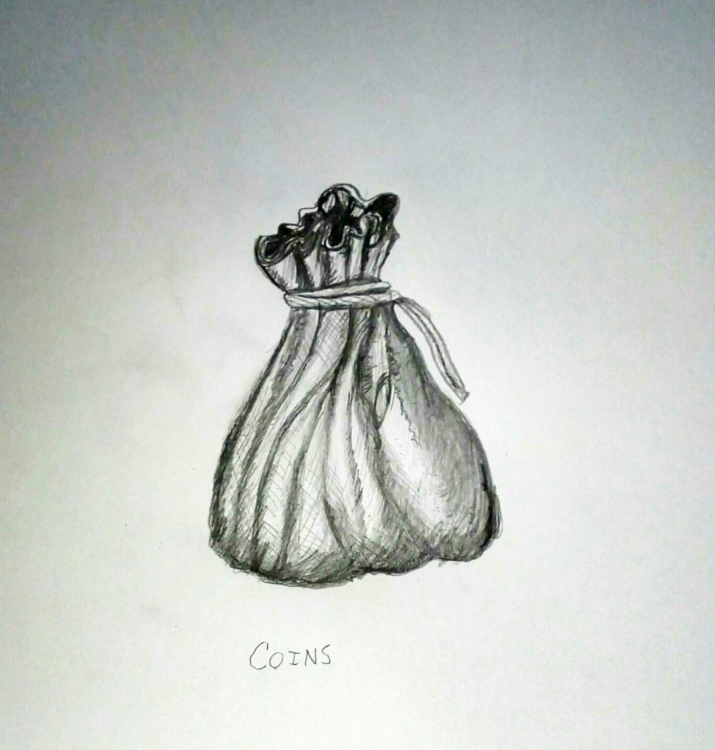




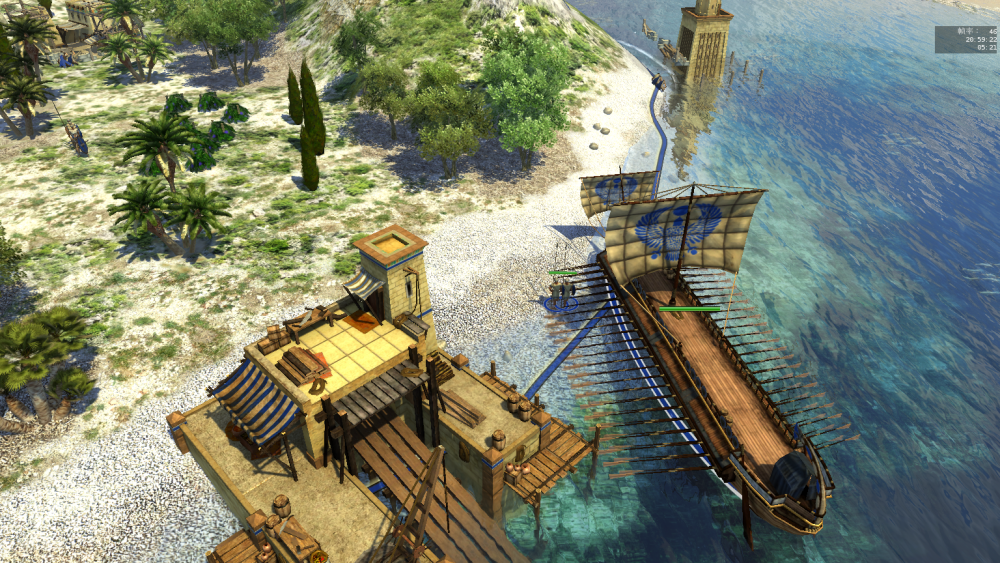
(1).thumb.gif.b5909d3df98a8ec15dc452423f219bc5.gif)
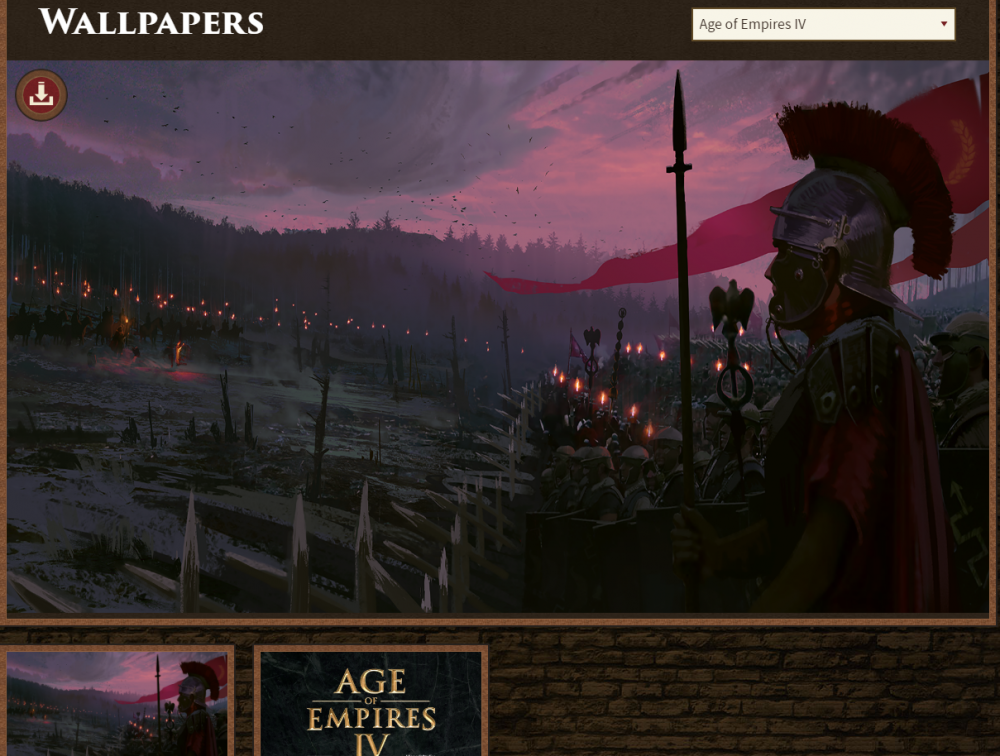
.thumb.jpg.b21ca1d0c15fb56b42c39b25a0a40815.jpg)
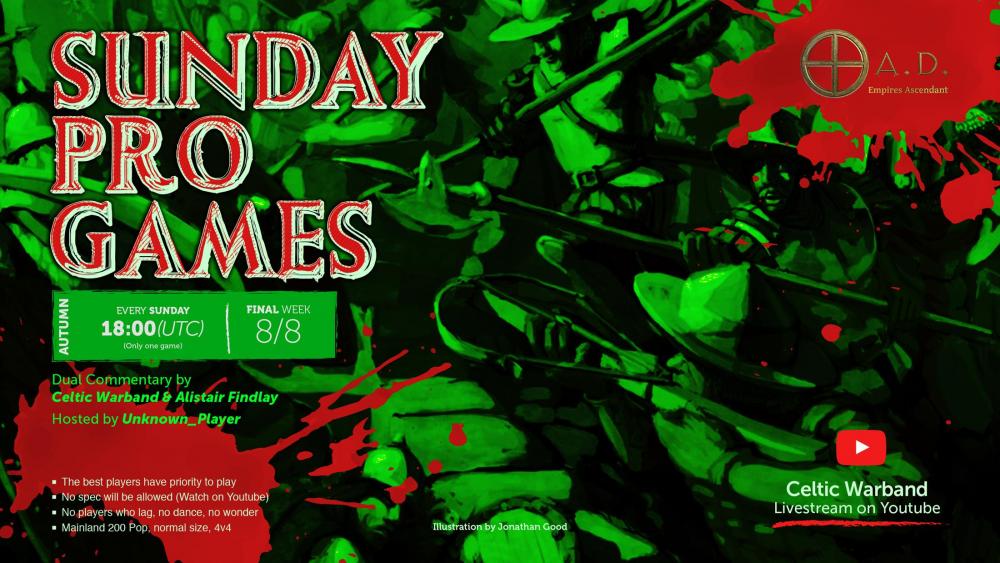
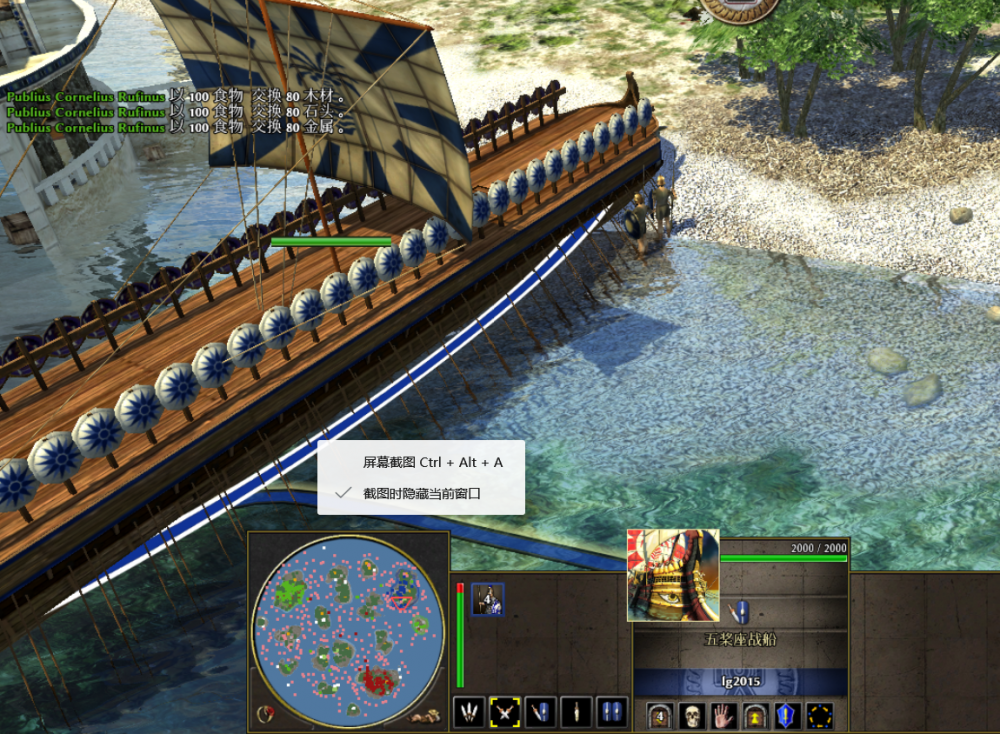

.thumb.jpeg.b945993fed9d67d756296f2cb42c4092.jpeg)
